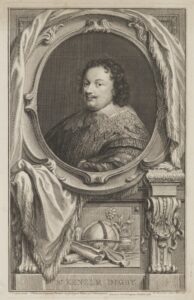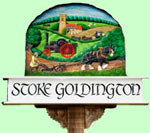Sir Kenelm restored the family’s reputation after his father’s involvement in the Gunpowder Plot by “the uncommon merits of its successor”, wrote George Lipscomb.
By all accounts he was a charismatic and effective man:-
“but, in 1636, he seceded to the Popish Communion and was placed under the care of Mr Thomas Allen, one of the most learned men of those times; who, discerning the natural strength of his faculties, directed him in the method of applying his wonderful capacity.”

Sir Kenelm Digby
In his earlier days Sir Kenelm distinguished himself in the Navy, and it is said that the badge which appears on the pillars of the front door and on the bases of the pillars in the yew hedges in front of the house, consisting of three bolt heads and a ring under a rope sling, is a sign of his right to moor his barge at the Royal Steps at Greenwich and Westminster. Later he became a well-known courtier and greatly interested in astrology.
In the main hall of the house is a semi-circular doorway where above the flanking Corinthian pillars the monogrammed initials K.D. appear.
The Lady Venetia, Sir Kenelm’s wife, was a consumptive and it is believed that he imported edible snails (Helix Pomatia) from the South of France for her, as these were thought to have curative properties for this complaint. It is true that this species of snail is still occasionally found in the district
How Kenelm, with his religious commitment, subsequently managed to remain loyal to the Crown is not clear but he held influential posts such as Gentleman of the Bedchamber and Commissioner of the Navy and acquired great honour by his gallantry.
He “was a great benefactor to the Bodleian Library, by presenting to it, in 1634, a large collection of MSS” and was also the author of several learned books.
He espoused the cause of King Charles I but his negotiating powers seemed to avoid prolonged controversy with the Parliament of the Commonwealth, despite spells of imprisonment followed by exile in the Civil War.
It is very surprising that, having travelled so much in Europe in the service of the king, and with his knowledge of Renaissance culture and his interest in science and art, that there is little evidence that he carried out alterations at Gayhurst.
He died in 1665 leaving two sons, the second of whom, John Digby Esq. succeeded at Gayhurst.
Sir Kenelm’s brother Sir John and his eldest son (of his own name) were killed fighting for King Charles, and he himself was exiled after having been imprisoned. His second son John succeeded him, dying in 1673.
For a more detailed Biography read more…
